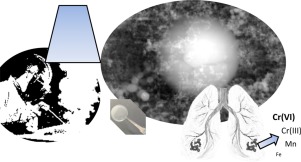当前位置:
X-MOL 学术
›
J. Hazard. Mater.
›
论文详情
Our official English website, www.x-mol.net, welcomes your feedback! (Note: you will need to create a separate account there.)
Size-separated particle fractions of stainless steel welding fume particles – A multi-analytical characterization focusing on surface oxide speciation and release of hexavalent chromium
Journal of Hazardous Materials ( IF 13.6 ) Pub Date : 2017-08-31 , DOI: 10.1016/j.jhazmat.2017.08.070 N. Mei , L. Belleville , Y. Cha , U. Olofsson , I. Odnevall Wallinder , K.-A. Persson , Y.S. Hedberg
Journal of Hazardous Materials ( IF 13.6 ) Pub Date : 2017-08-31 , DOI: 10.1016/j.jhazmat.2017.08.070 N. Mei , L. Belleville , Y. Cha , U. Olofsson , I. Odnevall Wallinder , K.-A. Persson , Y.S. Hedberg

|
Welding fume of stainless steels is potentially health hazardous. The aim of this study was to investigate the manganese (Mn) and chromium (Cr) speciation of welding fume particles and their extent of metal release relevant for an inhalation scenario, as a function of particle size, welding method (manual metal arc welding, metal arc welding using an active shielding gas), different electrodes (solid wires and flux-cored wires) and shielding gases, and base alloy (austenitic AISI 304L and duplex stainless steel LDX2101). Metal release investigations were performed in phosphate buffered saline (PBS), pH 7.3, 37°, 24 h. The particles were characterized by means of microscopic, spectroscopic, and electroanalytical methods Cr was predominantly released from particles of the welding fume when exposed in PBS [3–96% of the total amount of Cr, of which up to 70% as Cr (VI)], followed by Mn, nickel, and iron. Duplex stainless steel welded with a flux-cored wire generated a welding fume that released most Cr(VI). Nano-sized particles released a significantly higher amount of nickel compared with micron-sized particle fractions. The welding fume did not contain any solitary known chromate compounds, but multi-elemental highly oxidized oxide(s) (iron, Cr, and Mn, possibly bismuth and silicon).
中文翻译:

不锈钢焊烟颗粒的大小分离的颗粒级分–专注于表面氧化物形态和六价铬释放的多重分析表征
不锈钢的焊接烟雾可能对健康有害。这项研究的目的是研究与烟尘有关的焊接烟雾颗粒中的锰(Mn)和铬(Cr)形态及其与金属释放的程度,作为颗粒大小,焊接方法(手动金属电弧焊,使用活性保护气体的金属电弧焊,不同的电极(实心焊丝和药芯焊丝)和保护气体以及基础合金(奥氏体AISI 304L和双相不锈钢LDX2101)。在pH 7.3、37°,24 h的磷酸盐缓冲盐水(PBS)中进行金属释放研究。通过显微镜,光谱学和电分析方法对颗粒进行表征,当暴露于PBS中时,铬主要从焊烟颗粒中释放出来[占铬总量的3–96%,其中Cr(VI)的含量最高为70%,其次是Mn,镍和铁。用药芯焊丝焊接的双相不锈钢产生的焊接烟雾释放出大部分的Cr(VI)。与微米级颗粒级分相比,纳米级颗粒释放的镍量要高得多。焊接烟尘不包含任何已知的孤立铬酸盐化合物,而是包含多元素的高度氧化的氧化物(铁,铬和锰,可能包括铋和硅)。
更新日期:2017-09-04
中文翻译:

不锈钢焊烟颗粒的大小分离的颗粒级分–专注于表面氧化物形态和六价铬释放的多重分析表征
不锈钢的焊接烟雾可能对健康有害。这项研究的目的是研究与烟尘有关的焊接烟雾颗粒中的锰(Mn)和铬(Cr)形态及其与金属释放的程度,作为颗粒大小,焊接方法(手动金属电弧焊,使用活性保护气体的金属电弧焊,不同的电极(实心焊丝和药芯焊丝)和保护气体以及基础合金(奥氏体AISI 304L和双相不锈钢LDX2101)。在pH 7.3、37°,24 h的磷酸盐缓冲盐水(PBS)中进行金属释放研究。通过显微镜,光谱学和电分析方法对颗粒进行表征,当暴露于PBS中时,铬主要从焊烟颗粒中释放出来[占铬总量的3–96%,其中Cr(VI)的含量最高为70%,其次是Mn,镍和铁。用药芯焊丝焊接的双相不锈钢产生的焊接烟雾释放出大部分的Cr(VI)。与微米级颗粒级分相比,纳米级颗粒释放的镍量要高得多。焊接烟尘不包含任何已知的孤立铬酸盐化合物,而是包含多元素的高度氧化的氧化物(铁,铬和锰,可能包括铋和硅)。



























 京公网安备 11010802027423号
京公网安备 11010802027423号